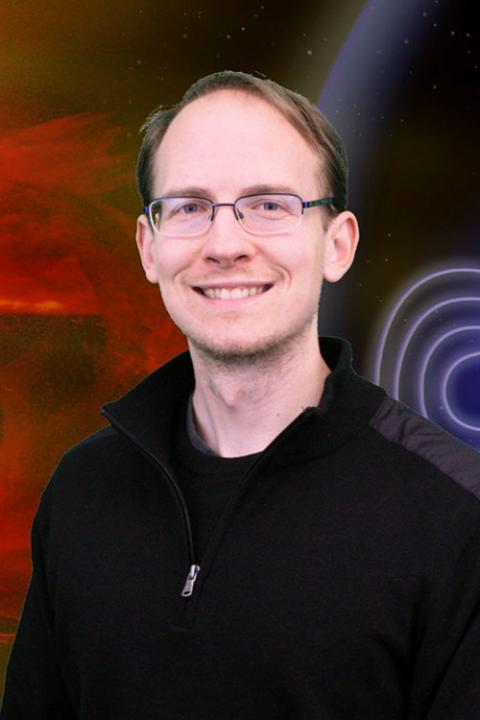
Jason Shuster
Why do I study space physics? I believe, like Guy Consolmango shared in this interview titled Asteroids, Stars, and the Love of God, that only human beings have the curiosity to ask questions like: "What's that up in the sky?", "How do we fit into that?", "Who are we?", "Where do we come from?", and that this curiosity is a hunger that is as deep and as important as a hunger for food, because if you starve a person in that sense, you are depriving them of their humanity.
Our entire modern society is currently powered by electricity. Solar flares and coronal mass ejections launched by the Sun are unfathomably large amounts of electrified gas called plasma that bombard Earth's magnetic field. Extreme solar eruptions like these:
- Threaten the lives of our astronauts going to the Moon, Mars, the International Space Station, and anywhere else in space.
- Trigger geomagnetic storms that destroy Starlink satellites and compromise our Global Positioning System (GPS) spacecraft.
- Damage our electrical power grids, such as this 1989 solar storm that led to a Hydro-Québec blackout.
My research interests are fueled both by curiosity about how plasmas behave kinetically, and how we can harness that knowledge to better understand the impacts space weather has on Earth in order to:
- Predict these extreme solar events and the geomagnetic storms they trigger here on Earth before they happen.
- Protect our astronauts from the extreme radiation risks they face when traveling through outer space.
- Preserve our space assets, including communications spacecraft that power our cell phones, internet services, and the GPS satellites on which we all now rely.
- Prevent our power grids from going down so they can survive the impact of intense geomagnetic storms.
- Power the future by better understanding how thermonuclear fusion fuels the Sun, and how to harness that energy source to power our own planet.
We discovered how to use data from outer space to measure what is known as the Vlasov equation, held by many to be the most important equation in plasma physics. Beginning with Ludwig Boltzmann's insights from the late 1800s regarding microscopic motions of ordinary gases, Anatoly Vlasov in 1945 applied Boltzmann's ideas to understand the nature of electrified gases called plasmas. What has prevented researchers from measuring the Vlasov equation for over 100 years since Boltzmann? The difficulty is that Vlasov's equation lives in phase space, which enlists no less than seven dimensions — three for position (x, y, z), three for velocity (vx, vy, vz), and one for time (t) — thus, for over a century, no experiment has been designed to sufficiently and accurately resolve each of these dimensions. Today, instruments comprising the revolutionary Fast Plasma Investigation (FPI) onboard NASA's record-breaking four spacecraft Magnetospheric Multiscale (MMS) mission, flying over 40,000 miles away from Earth through regions where the magnetic fields of the Earth and Sun collide, equip space scientists with data collected at higher resolution than ever before achieved
Education
- Ph.D., Physics, University of New Hampshire
Research Interests
- Magnetospheric Phenomena
- Applied Physics
- Applied Mathematics
- Computational Physics
- Computational Mathematics
- Plasma Physics
- Interplanetary Spacecraft
- Space Weather
- Space Sciences
- Spacecraft
- Fluid/Magnetohydrodynamic Physics
- Mathematical Physics
- Complex Analysis
- 3D Modeling / Visualization
- Computer Simulation/Modeling
- Mathematics Education
- Physics
- Fluid Physics
- Fluid/Electrohydrodynamic Physics
Selected Publications
Beedle, J. M. H., Genestreti, K. J., Shuster, J. R., Rice, R. C., Fuselier, S. A., Phan, T. D., . . . Torbert, R. B. (2025). MMS Observations of a Compressed, Strongly Driven Magnetopause During the 2024 Mother's Day Storm. Geophysical Research Letters, 52(24). doi:10.1029/2025gl118368
Norgren, C., Chen, L. -J., Graham, D. B., Bessho, N., Egedal, J., Richard, L., . . . Argall, M. (2025). Electron and Ion Dynamics in Reconnection Diffusion Regions. Space Science Reviews, 221(5). doi:10.1007/s11214-025-01197-z
Beedle, J. M. H., Gershman, D. J., Shuster, J. R., Uritsky, V. M., Phan, T. D., Norgren, C., . . . Torbert, R. B. (2025). The Diffusion Interaction Region of Dayside Magnetic Reconnection. Journal of Geophysical Research: Space Physics, 130(5). doi:10.1029/2024ja033680
Hasegawa, H., Argall, M. R., Aunai, N., Bandyopadhyay, R., Bessho, N., Cohen, I. J., . . . Zenitani, S. (2024). Advanced Methods for Analyzing in-Situ Observations of Magnetic Reconnection.. Space Sci Rev, 220(6), 68. doi:10.1007/s11214-024-01095-w
Argall, M., McGranaghan, R., Smith, A., Klein, K., Bortnik, J., Chen, T. Y., . . . Shuster, J. (2023). Intelligent Missions in the Living Heliospheric System Observatory. Bulletin of the AAS. doi:10.3847/25c2cfeb.abb7e520
Cohen, I. J., Schwartz, S. J., Goodrich, K. A., Ahmadi, N., Ergun, R. E., Fuselier, S. A., . . . Burch, J. L. (2019). High-Resolution Measurements of the Cross-Shock potential, Ion Reflection, and Electron Heating at an Interplanetary Shock by MMS. JOURNAL OF GEOPHYSICAL RESEARCH-SPACE PHYSICS, 124(6), 3961-3978. doi:10.1029/2018JA026197
Torbert, R. B., Burch, J. L., Phan, T. D., Hesse, M., Argall, M. R., Shuster, J., . . . Saito, Y. (2018). Electron-scale dynamics of the diffusion region during symmetric magnetic reconnection in space. SCIENCE, 362(6421), 1391-+. doi:10.1126/science.aat2998
Rager, A. C., Dorelli, J. C., Gershman, D. J., Uritsky, V., Avanov, L. A., Torbert, R. B., . . . Saito, Y. (2018). Electron Crescent Distributions as a Manifestation of Diamagnetic Drift in an Electron-Scale Current Sheet: Magnetospheric Multiscale Observations Using New 7.5 ms Fast Plasma Investigation Moments. GEOPHYSICAL RESEARCH LETTERS, 45(2), 578-584. doi:10.1002/2017GL076260
Torbert, R. B., Burch, J. L., Giles, B. L., Gershman, D., Pollock, C. J., Dorelli, J., . . . Bounds, S. (2016). Estimates of terms in Ohm's law during an encounter with an electron diffusion region. GEOPHYSICAL RESEARCH LETTERS, 43(12), 5918-5925. doi:10.1002/2016GL069553
Shuster, J. R., Chen, L. -J., Hesse, M., Argall, M. R., Daughton, W., Torbert, R. B., & Bessho, N. (2015). Spatiotemporal evolution of electron characteristics in the electron diffusion region of magnetic reconnection: Implications for acceleration and heating. GEOPHYSICAL RESEARCH LETTERS, 42(8), 2586-2593. doi:10.1002/2015GL063601